Did you know that over 81% of Filipinos practice Catholicism, a legacy of over 300 years of colonial history? This profound influence has shaped the country’s social norms and daily practices in ways that are still evident today.
From family gatherings to formal events, many Filipino traditions trace their roots to historical influences. For instance, the importance of punctuality, or “Filipino time,” often reflects a blend of local and inherited practices.
Understanding these connections helps us appreciate how deeply intertwined cultures can become. Whether it’s the way people greet each other or the significance of certain holidays, these customs are a testament to a shared history.
Key Takeaways
- Filipino etiquette is deeply influenced by historical traditions.
- Family gatherings and social events reflect these cultural ties.
- Punctuality practices often blend local and inherited customs.
- Major holidays in the Philippines have roots in historical influences.
- Understanding these connections enriches cultural appreciation.
Introduction to the Cultural Connection
Spain’s vibrant culture has left a lasting mark on many societies, including the Philippines. Known for its warm, laid-back lifestyle, Spain’s approach to life emphasizes community, celebration, and shared experiences. These values have transcended borders, influencing cultural behaviors in profound ways.
Daily practices in Spain, such as meal times and social rituals, reflect this welcoming spirit. For example, lunch is the main meal of the day, often enjoyed between 2:00 and 3:00 pm. This tradition fosters a sense of togetherness, as families and friends gather to share food and conversation.
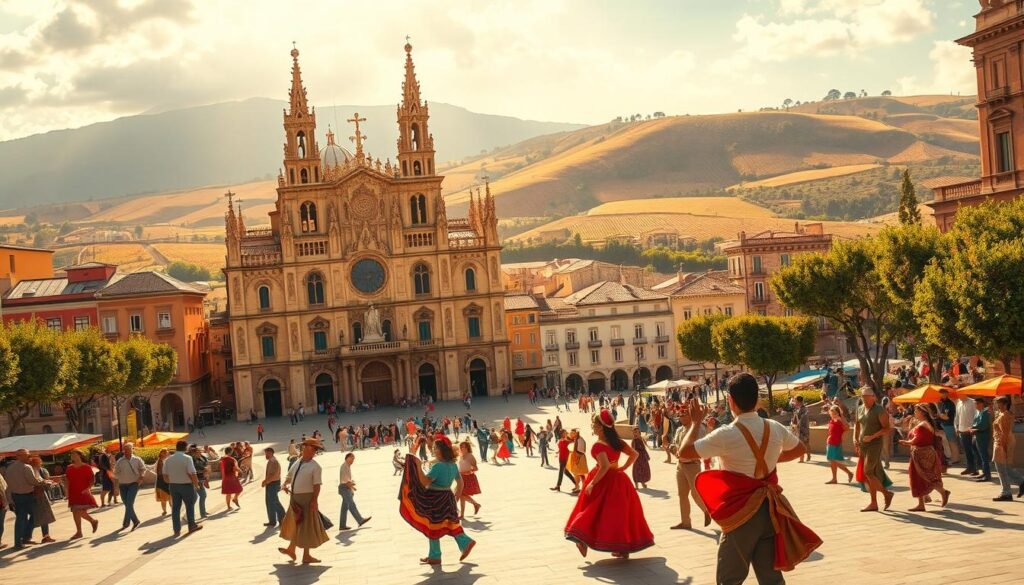
Festive traditions, like the lively dance of flamenco, also play a significant role in everyday life. These performances are not just entertainment but a way to express emotions and connect with others. Similarly, the ritual of enjoying tapa—small, flavorful dishes—highlights the importance of savoring moments with loved ones.
Historical figures like Miguel de Cervantes further exemplify Spain’s cultural influence. His works, such as Don Quixote, continue to inspire creativity and storytelling worldwide. These elements collectively showcase how Spain’s traditions have shaped global practices.
Understanding these connections helps us appreciate the shared history between Spain and the Philippines. From family gatherings to festive celebrations, these cultural ties remain a testament to the enduring impact of Spain’s heritage.
Historical Evolution of Spanish Traditions
The blending of cultures during Spain’s colonial era created a unique fusion still visible today. From the Philippines to Latin America, these influences have shaped cultural identities and daily practices. This section explores how historical events and religious traditions have left a lasting legacy.
Colonial History and Cultural Fusion
Spain’s colonial expansion in the 16th century brought significant changes to many regions. The Philippines, under Spanish rule for over 300 years, saw a blend of local and foreign customs. This fusion is evident in language, architecture, and daily routines.
For example, the practice of sobremesa—lingering at the table after meals—reflects the importance of community. This tradition, rooted in Spanish culture, remains a cherished part of Filipino family life.
Religious Influences and Celebrations
Religion played a central role in shaping social traditions. Spain’s Catholic heritage introduced festivals like Semana Santa (Holy Week) and La Tomatina. These events highlight the deep connection between faith and community.
In the Philippines, religious processions and fiestas are a testament to this shared history. As one historian noted,
“The intertwining of faith and festivity reflects a cultural legacy that transcends borders.”
| Event | Origin | Modern Practice |
|---|---|---|
| Semana Santa | Spain | Observed with solemn processions in the Philippines |
| La Tomatina | Spain | Celebrated as a lively festival in some Filipino towns |
| Fiestas | Spain | Integral part of Filipino community life |
These traditions, passed down through generations, continue to shape home and community life. From meal times to festive celebrations, the echoes of Spain’s influence remain strong.
Defining Spanish Social Customs
Spain’s vibrant traditions have shaped daily life in ways that resonate globally. These practices are not just routines but a way to foster community and connection. From festive celebrations to unique daily rhythms, they highlight the importance of togetherness.
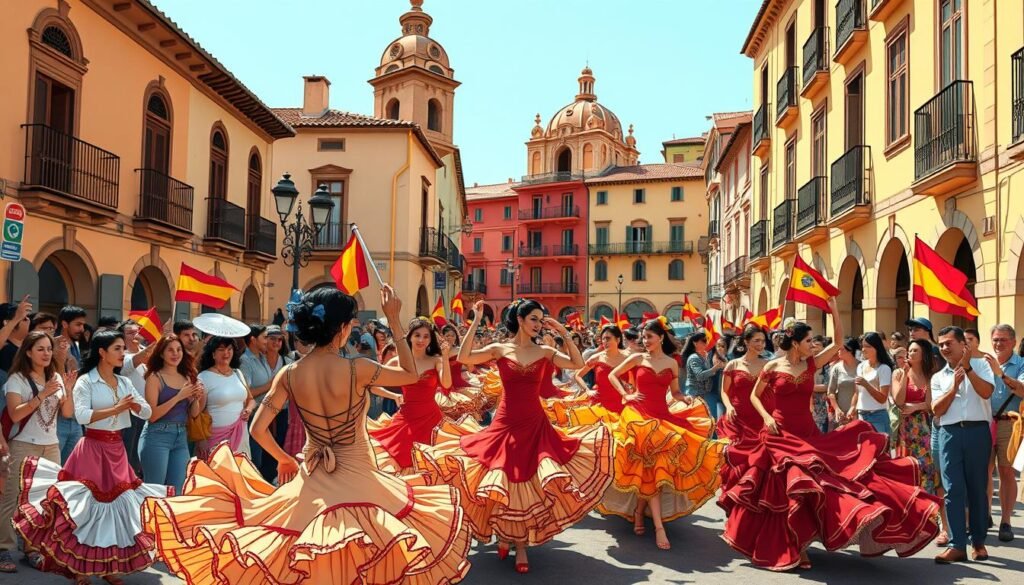
Key Traditions and Festivities
Spain’s social calendar is filled with events that bring people together. La Tomatina, a tomato-throwing festival, and Semana Santa, a solemn religious observance, are prime examples. These celebrations mark the rhythm of the day and set the tone for community life.
Work-life balance is another cornerstone of these traditions. The siesta, a midday break, allows people to recharge and spend time with family. This practice reflects the value placed on relaxation and personal connections.
Music and dance play a central role in festivities. Flamenco, with its passionate rhythms, is more than just a performance—it’s an expression of emotion and culture. These art forms bring people together, creating a sense of unity and joy.
- La Tomatina and Semana Santa are key events that define the social calendar.
- The siesta tradition emphasizes the importance of rest and family time.
- Music and dance are integral to celebrations, fostering community bonds.
These customs influence not only local society but also broader cultural events. They serve as a reminder of the power of shared traditions in building strong communities.
Daily Life: From Siesta to Social Gatherings
The rhythm of daily life in Spain is deeply rooted in traditions that prioritize balance and connection. From the midday siesta to late-night gatherings, these practices reflect a unique cultural rhythm that fosters both productivity and personal well-being.
Meal Times and the Siesta Culture
In Spain, the day is structured around meal times and rest. Lunch, the main meal, is typically enjoyed between 2:00 and 3:00 pm, followed by the siesta. This midday break allows people to recharge and spend time with family.
Historically, the siesta was essential for agrarian societies, providing relief during the hottest part of the day. Today, while urban areas have seen a decline in this practice, rural communities still embrace it as a way to maintain a healthy work-life balance.
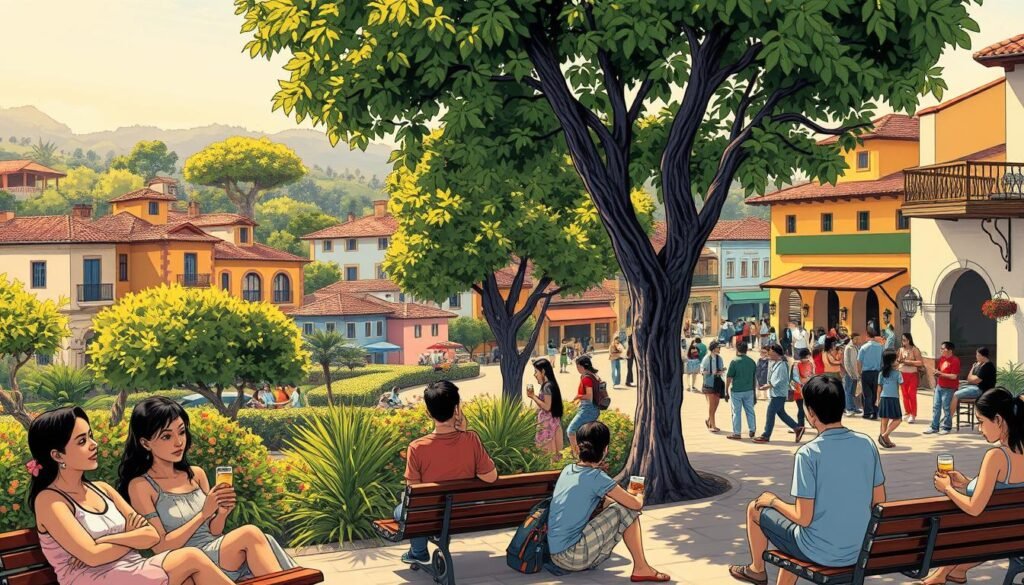
Modern adaptations include condensed workdays, with businesses closing in the afternoon and reopening in the evening. This approach aligns with international business hours while preserving the essence of the siesta tradition.
Greeting Etiquette and Social Rituals
Greetings in Spain are warm and personal, often involving a kiss on both cheeks or a firm handshake. These rituals emphasize the importance of connection and set the tone for social interactions.
Friendship is highly valued, with gatherings often lasting late into the night. As one observer noted,
“In Spain, time spent with friends is never wasted.”
This sentiment underscores the cultural emphasis on community and shared experiences.
| Aspect | Traditional Practice | Modern Adaptation |
|---|---|---|
| Meal Times | Lunch at 2:00 pm, followed by siesta | Condensed workdays with flexible hours |
| Greetings | Kiss on both cheeks | Handshake or verbal greeting |
| Social Gatherings | Late-night dinners and fiestas | Shorter events with a focus on quality time |
These daily practices serve as models for balanced and community-focused lifestyles. Whether it’s the siesta or a late-night gathering, they highlight the enduring importance of rest, connection, and friendship in spanish culture.
Impact on Filipino Cultural Practices
Family and community are central to the Filipino way of life. Over centuries, foundational practices have shaped values that emphasize togetherness and respect. These traditions are a part of the cultural identity that continues to thrive today.
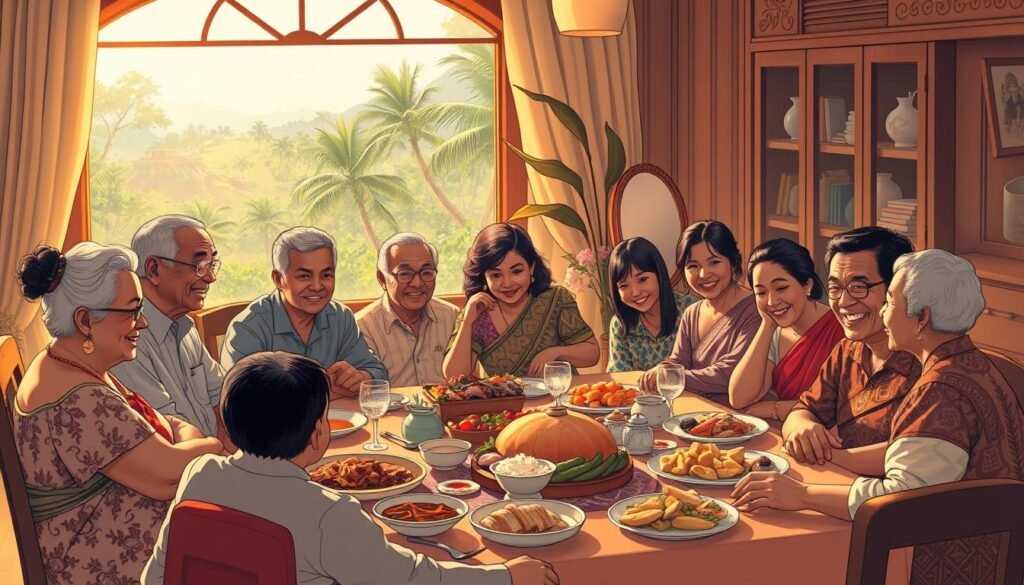
Family Values and Community Bonds
From colonial times to modern society, social practices have evolved while retaining their core essence. Shared meals, for example, are a cherished tradition that brings families together. Festive celebrations, often featuring treats like chocolate, highlight the importance of joy and unity.
Communal bonds are strengthened through events like fiestas, which blend local and inherited customs. These gatherings are not just celebrations but a way to honor traditions and foster connections. As one observer noted,
“Filipino culture is a testament to the enduring power of shared history.”
- Shared meals and festive gatherings emphasize family togetherness.
- Fiestas blend local and foreign traditions, creating a unique cultural identity.
- Respect for tradition is a cornerstone of Filipino values.
These practices place Filipino culture in a broader global context. They showcase how historical influences continue to shape modern life, making the Philippines a vibrant part of the world’s cultural tapestry.
The Role of Language and Communication
Language serves as the backbone of cultural identity, shaping how communities connect and thrive. From formal greetings to casual street-level interactions, it plays a pivotal role in expressing and maintaining traditions. This section explores how communication practices, including naming conventions and bilingual dialogue, bridge cultural nuances and strengthen social bonds.
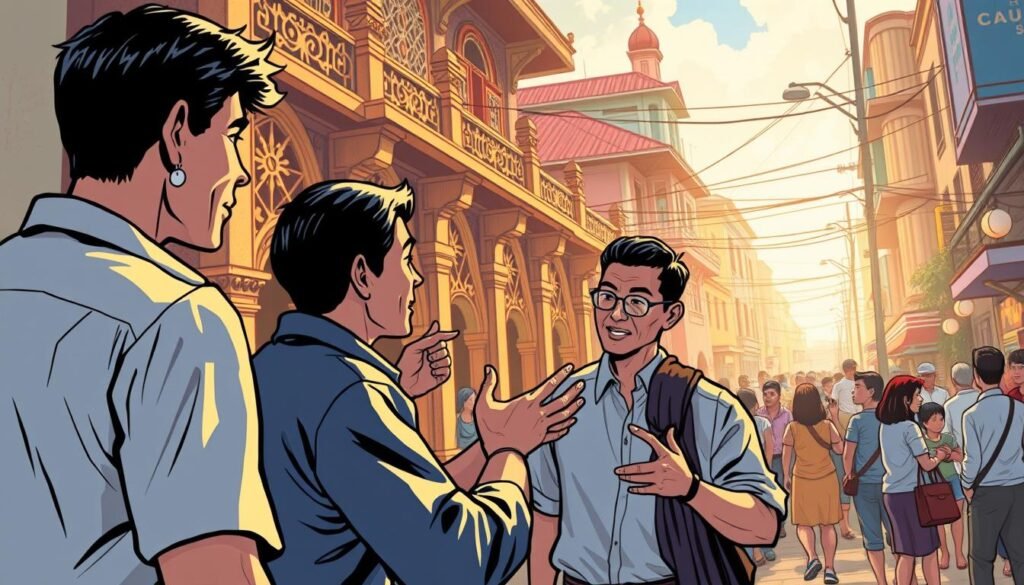
Formal Greetings and Naming Conventions
In many cultures, formal greetings are more than just polite gestures—they reflect respect and tradition. For example, using titles like “Señor” or “Señora” in Spanish-speaking communities emphasizes politeness and hierarchy. Proper naming conventions also play a significant role in establishing social connections.
In the Philippines, the use of “po” and “opo” in conversations shows respect for elders. These practices highlight the importance of language in fostering relationships. As one observer noted,
“The way we address others speaks volumes about our values and upbringing.”
Bilingual Interactions and Social Nuances
Bilingualism is a powerful tool for bridging cultural gaps. In Spain, many regions speak both Castilian and regional languages like Catalan or Basque. This linguistic diversity enriches daily life and fosters a deeper understanding of cultural heritage.
In the Philippines, the blend of local dialects and English creates a unique communication style. This bilingual approach helps navigate social nuances, making interactions more inclusive. For instance, switching between languages during a conversation can signal familiarity and trust.
Street-level communication also plays a vital role in building community bonds. Casual chats in the town square or market often lead to lasting friendships. These interactions, combined with shared traditions like preparing a local dish, strengthen the fabric of society.
Language is more than a means of communication—it’s a reflection of identity and shared history. By understanding its role, we can appreciate the intricate ways it shapes our life and connects us to others. For more insights on communication styles, visit the Cultural Atlas.
Business and Professional Etiquette Influences
Professional interactions often reflect deep-rooted traditions that shape business etiquette. From networking norms to meeting customs, these practices highlight the importance of personal connections and cultural heritage.
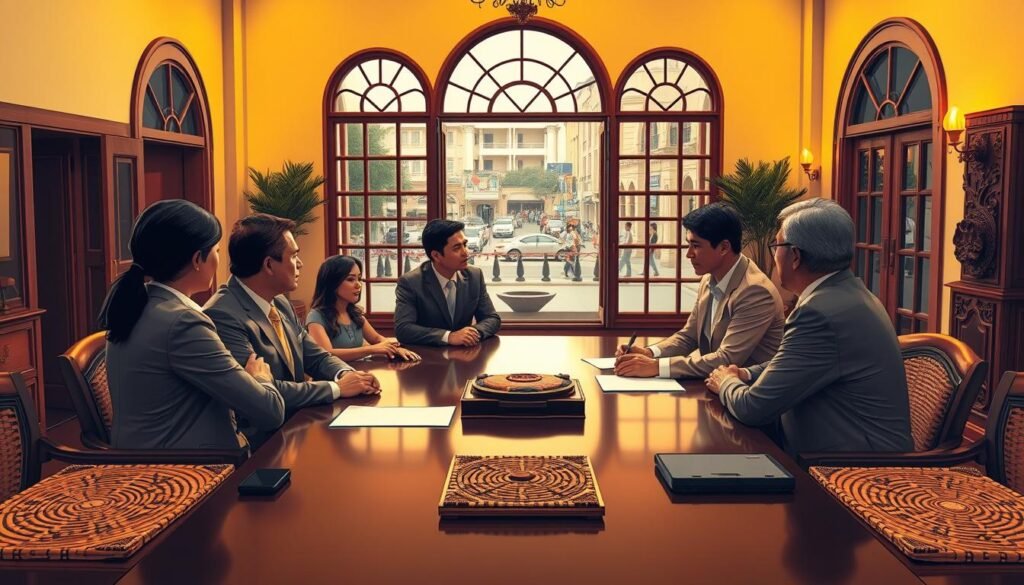
Networking Norms and Meeting Customs
In many professional settings, punctuality is a key aspect of business etiquette. While being 15-30 minutes late might be acceptable in some cultures, it’s essential to respect the time of others. This balance between flexibility and punctuality is a hallmark of tradition.
Formal introductions and gift-giving are also significant. A small token of appreciation, such as a local drink or delicacy, can go a long way in building rapport. As one expert noted,
“The way you present yourself in a meeting sets the tone for the entire relationship.”
Adapting Practices in Business Settings
Sharing meals and drinks is a common practice in business contexts. It fosters trust and strengthens personal bonds. This approach, rooted in historical influences, emphasizes the value of community and collaboration.
Historical figures like Miguel Cervantes have also left their mark on professional norms. Their emphasis on storytelling and creativity continues to inspire modern business practices. For instance, using emotional appeals in negotiations can create a deeper connection with clients.
Comparing these practices to Filipino business etiquette reveals striking similarities. Both cultures prioritize respect, personal connections, and the blending of tradition with modern practices. Understanding these nuances can enhance cross-cultural collaboration and success.
For more insights into professional etiquette, visit Expatica’s guide on Spanish business culture.
Modern Adaptations of Traditional Customs
Globalization has reshaped traditional practices in ways that blend the old with the new. In Spain, this evolution is particularly evident in urban centers, where historical customs are being reimagined to fit contemporary lifestyles. From business practices to daily routines, the balance between preserving heritage and embracing progress is a delicate yet dynamic process.
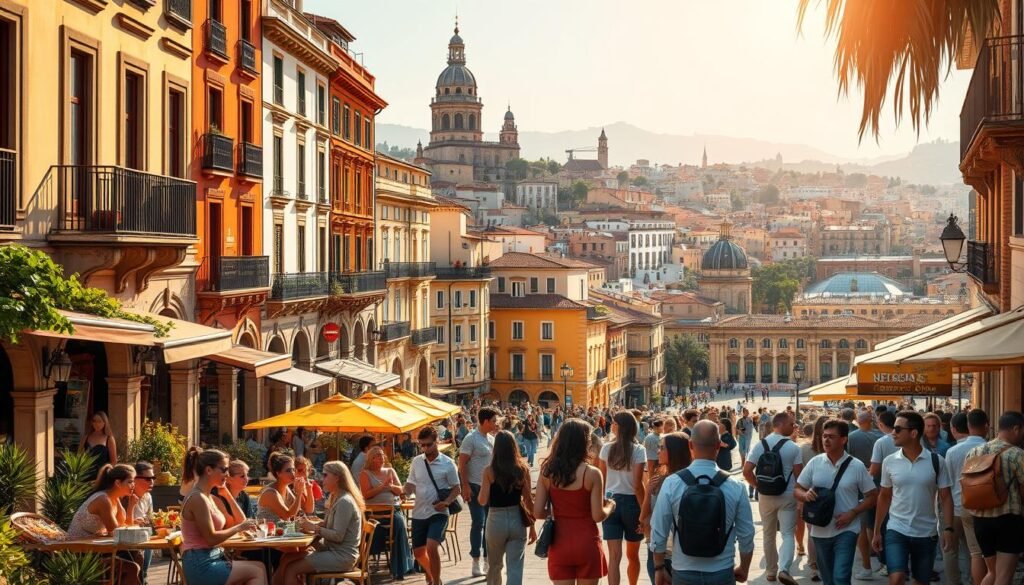
Cultural Shifts in a Globalized World
In cities like Barcelona and Madrid, traditional customs are adapting to global influences. For instance, the siesta, once a cornerstone of daily life, is now less common in fast-paced business environments. However, its essence remains in the form of flexible work hours, allowing people to maintain a healthy work-life balance.
Regions like Catalonia showcase how local traditions can thrive alongside modern innovations. Festivals such as La Mercè blend historical rituals with contemporary art and music, attracting both locals and tourists. This fusion highlights the region’s ability to honor its past while embracing the future.
In the culinary world, traditional dishes are being reinvented to cater to global tastes. For example, meat-based recipes like paella now feature vegetarian or vegan alternatives, reflecting changing dietary preferences. This adaptability ensures that cultural heritage remains relevant in a diverse and interconnected world.
As one expert noted,
“The key to preserving tradition lies in its ability to evolve without losing its core identity.”
This sentiment underscores the importance of innovation in keeping cultural practices alive.
For more insights into how Spain balances tradition and modernity, visit this detailed guide.
Festivals, Food, and Music: A Cross-Cultural Blend
Festivals, food, and music are the heartbeats of cultural identity, connecting communities across generations. These elements not only celebrate heritage but also foster unity and shared experiences. From the vibrant streets of Spain to the lively fiestas in the Philippines, they reflect a deep-rooted connection that transcends borders.
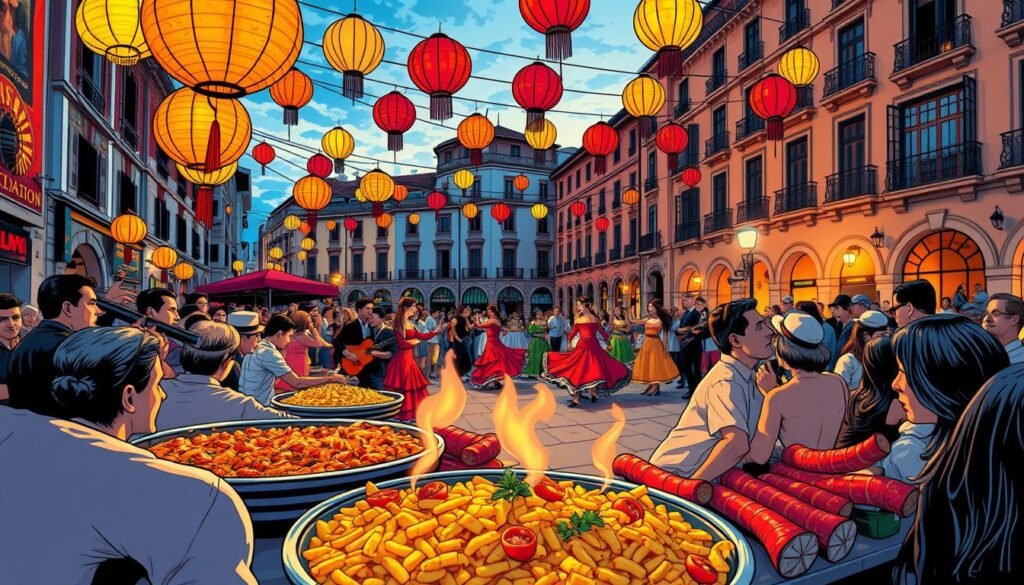
Culinary Traditions and Iconic Dishes
Food plays a central role in cultural celebrations, with iconic dishes like paella symbolizing the essence of a region. Originating from Valencia, this flavorful rice dish is a staple at festivals and family gatherings. Its versatility allows it to adapt to local tastes, making it a beloved dish worldwide.
In the Philippines, culinary traditions like lechon and adobo showcase a similar blend of local and foreign influences. These dishes are often served during fiestas, highlighting the importance of food in bringing people together. As one observer noted,
“A shared meal is more than nourishment—it’s a celebration of culture and community.”
Rhythms of Dance and Musical Heritage
Music and dance are integral to cultural expression, with flamenco being a hallmark of Spaniard heritage. This passionate art form, characterized by its intricate footwork and emotional intensity, is a testament to the power of storytelling through movement.
In the Philippines, traditional dances like the tinikling and pandanggo sa ilaw reflect a similar blend of rhythm and grace. These performances are often featured at festivals, showcasing the country’s rich cultural tapestry. Whether it’s the fiery steps of flamenco or the delicate movements of tinikling, dance serves as a universal language of connection.
| Element | Spain | Philippines |
|---|---|---|
| Iconic Dish | Paella | Lechon |
| Traditional Dance | Flamenco | Tinikling |
| Festival Highlight | La Tomatina | Sinulog Festival |
These traditions, whether in Spain or the Philippines, highlight the enduring power of festivals, food, and music in shaping cultural identity. For more insights into the rich tapestry of Spaniard culture, visit this detailed guide.
Embracing Spanish Social Customs in Contemporary Filipino Etiquette
From the streets of Madrid to the homes in Manila, cultural practices have transcended borders. Over the years, Filipino society has embraced and adapted these traditions, creating a unique blend of old and new. This fusion is evident in daily interactions, celebrations, and even in the way people approach food.
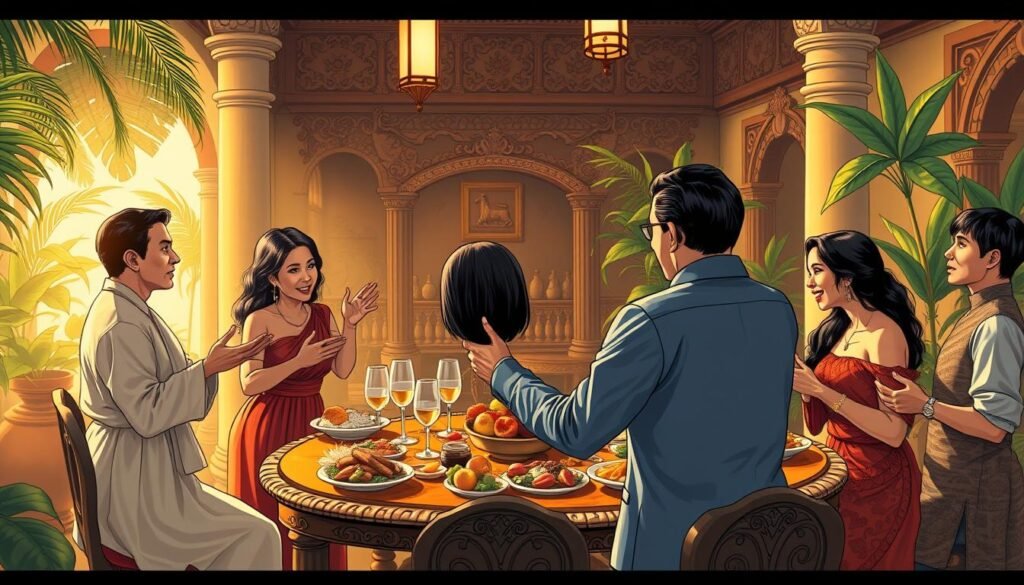
Lessons Learned from Historical Practices
One of the most enduring lessons from historical practices is the importance of community. In Valencia, shared meals like paella foster a sense of togetherness. Similarly, Filipino fiestas bring families and neighbors together, showcasing the value of unity. As one observer noted,
“The essence of tradition lies in its ability to connect people across generations.”
Modern Filipino society can also learn from the emphasis on balance. The siesta, a practice rooted in Madrid, highlights the importance of rest and personal well-being. While urban lifestyles have evolved, the spirit of this tradition remains in flexible work hours and family-focused routines.
Celebrations like Sinulog and Pahiyas reflect the blending of historical and modern influences. These events not only honor the past but also adapt to contemporary tastes, ensuring their relevance. For example, traditional dishes like lechon are now paired with modern twists, appealing to younger generations.
Understanding these connections enriches Filipino cultural identity. By integrating historical wisdom into modern practices, society can preserve its heritage while embracing progress. For more insights into how Spanish influences shape Filipino traditions, explore this detailed guide.
Conclusion
The rich interplay of historical and modern influences has shaped Filipino etiquette in profound ways. From family gatherings to business meetings, the echoes of shared traditions continue to define social interactions. Daily routines, such as meal times and rest periods, reflect a blend of cultural practices that prioritize balance and connection.
Celebrations and occasions also highlight this cultural fusion. Festivals and fiestas bring communities together, showcasing the enduring importance of unity and respect. These events are not just about tradition but also about adapting to contemporary lifestyles, ensuring their relevance for future generations.
In schools and workplaces, the emphasis on personal relationships and hospitality remains strong. These values, rooted in historical practices, continue to shape modern etiquette. By appreciating these shared legacies, we can foster a deeper understanding of cultural diversity.
To explore more about how cultural traditions influence daily life, visit this detailed guide. Embracing these practices enriches our lives and strengthens our connections to the past and present.
FAQ
How did Spanish traditions influence Filipino culture?
During the colonial period, Spain introduced many customs, including religious practices, festivals, and family values, which became deeply rooted in Filipino life.
What are some key Spanish traditions still practiced in the Philippines?
Festivals like Sinulog and Pahiyas, along with religious events such as Simbang Gabi, showcase the lasting impact of Spanish culture.
How does the siesta culture affect daily life in Spain and the Philippines?
The siesta, a midday break, influences work schedules and meal times, though it’s less common in urban areas of the Philippines today.
What role does food play in blending Spanish and Filipino cultures?
Dishes like paella and lechon highlight the fusion of culinary traditions, creating a unique gastronomic identity.
How do Spanish social rituals influence Filipino greetings?
Formal greetings, such as using titles like Señor or Señora, reflect the Spanish emphasis on respect and politeness.
What are some examples of Spanish-influenced Filipino festivals?
Events like Ati-Atihan and Moriones Festival blend indigenous and Spanish elements, celebrating both cultures.
How has Spanish music and dance shaped Filipino traditions?
Dances like Tinikling and music styles such as kundiman incorporate Spanish rhythms, creating a rich cultural tapestry.
What are the similarities between Spanish and Filipino business etiquette?
Both cultures value personal relationships, formal introductions, and networking as essential parts of professional interactions.
How do modern Filipinos adapt traditional Spanish customs?
While maintaining core traditions, Filipinos often blend them with contemporary practices, reflecting a globalized society.
What lessons can be learned from the historical fusion of Spanish and Filipino cultures?
The blending of these cultures highlights the importance of adaptability and mutual respect in shaping a shared identity.
Source Links
- Spanish influence on Filipino culture
- Spanish Colonial Influences on Filipino Culture
- Philippines – Spanish Colonization, Culture, Trade | Britannica
- Spain – Culture, Cuisine, Traditions | Britannica
- The Spanish Influence on Filipino Culture and Language
- Culture of Spain
- Spanish Culture: Traditions, Etiquette, and History of Spain
- Spanish Culture: Past and Present
- Spanish Culture, Customs, and Values – Study in Spain
- Spanish – Core Concepts
- Exploring the Spanish Siesta: A Deep Dive into Cultural Norms
- La siesta in Spanish Culture
- What is Life Like in Spain? Timetable, Social Life, Food and Travel
- The Impact of Spanish Colonization on Filipino Culture – Pinas Culture
- Spanish in the Philippines: Language, Heritage, and Modern Influence
- Language, Culture, Customs and Etiquette
- The Role of Spanish in Global Communication | Vamos Academy
- Business Culture and Etiquette in Spain | Today Translations
- Spanish – Business Culture
- A Brief Introduction to Spanish Culture, Traditions, and Beliefs
- No title found
- Festival
- Spanish culture: A lively guide to traditions, customs & facts
- The ebb and flow of Spanish influence on Filipino culture – Decolonising Modern Languages and Cultures
- Philippines – Culture, Diversity, Traditions | Britannica
- From Tradition to Identity: Exploring the Cultural Heritage of the Philippines
- Spain – Cultural Etiquette – e Diplomat

